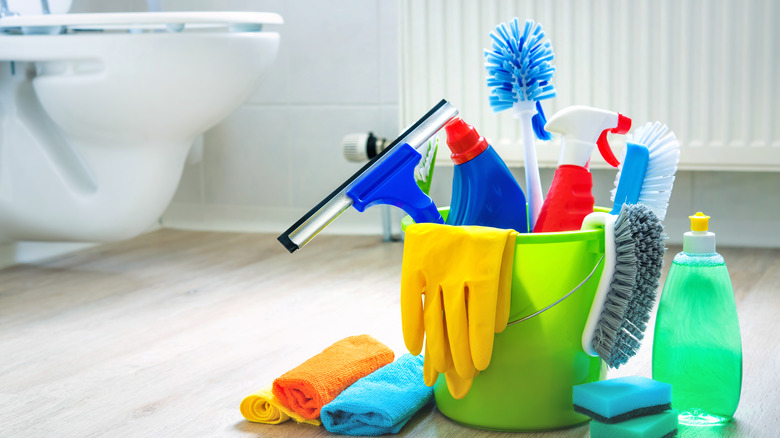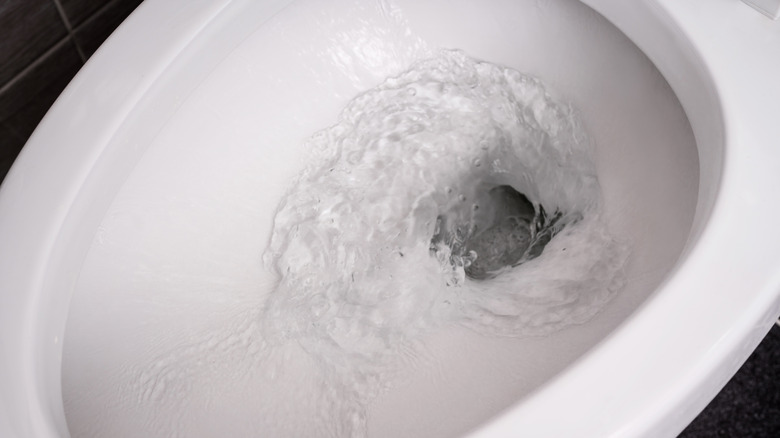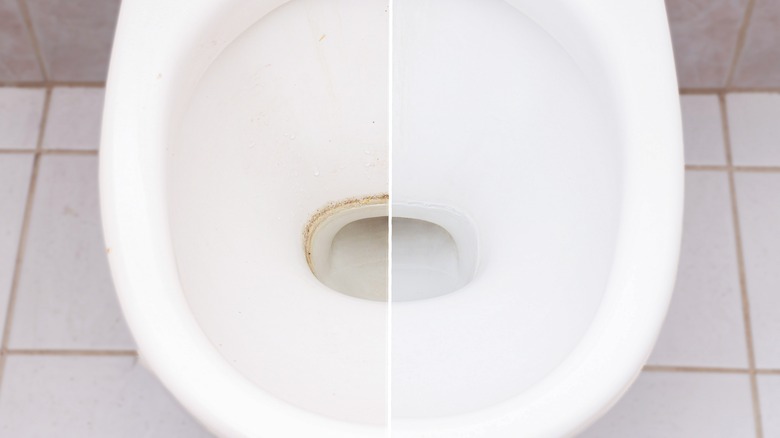The Crucial Step Everyone Forgets When Cleaning The Toilet
To many, cleaning the toilet is a straightforward routine — put on gloves, grab a brush, pour in the cleaner, scrub, and flush. However, many overlook a crucial initial step: emptying the toilet bowl of its water. This step isn't simply about hitting the flapper; it's about ensuring that the majority of the water is out of the bowl. This can be done by shutting off the water valve. But why is this so vital?
For starters, the water in your bowl can make your cleaning solution less potent. This can drastically reduce its ability to deal with stains, germs, and build-up. This could also cause you to have to work harder and use additional cleaning products. Moreover, when the water level remains high, you won't have clear access to clean all the areas inside the bowl. This means potential hidden stains and germs could remain untouched. When washing dishes, you wouldn't clean them in a dirty sink for hygiene reasons. Similarly, when cleaning the toilet, lowering the water level is essential for full visibility, proper cleaning, and access.
How to remove the water from your toilet bowl
Understanding the importance of an empty bowl while cleaning the toilet is one thing; knowing how to turn off the water valve is another. While it might seem like a labor-intensive step to the uninitiated, it's surprisingly straightforward and can make a world of difference to the end result. First, it's crucial to locate the water valve, which is typically found at the base of your toilet and usually on the left side. This valve regulates the water flow to the toilet. Turning it off will ensure that, post-flush, the bowl won't refill with water. So, gently turn this valve in the clockwise direction until it's in the off position. This ensures that once you flush, the water will exit the bowl without being replenished.
With the water supply interrupted, go ahead and flush the toilet. However, it's important to note that the water won't empty completely with just a flush. This is where a bit of manual intervention comes into play. Using a small, preferably disposable cup or sponge, you'll need to remove the residual water. This might take a bit of patience, but remember, it's about setting the stage for a proper clean. By removing this excess water, you'll ensure that every inch of the bowl's interior is ready for your cleaning products. Once you're done cleaning, you can turn the water valve back on.
Benefits of removing the water from your toilet bowl
When you consider the act of cleaning, especially something as frequently used as a toilet, it's not just about achieving a superficial shine. It's about ensuring that every inch of the surface is devoid of germs, bacteria, and unsightly stains. Therefore, the act of emptying the bowl isn't just a procedural step — it's the gateway to achieving a deeper, more thorough clean. But let's delve deeper into the other benefits of this approach.
One of the most immediate benefits of an empty bowl is the potency of your cleaning agents. Without the diluting effect of water, the toilet bowl cleaner can act at its full capacity. This means that every swipe of your brush is loaded with the full power of bleach or whatever product you are partial to. By ensuring that your cleaner isn't diluted, you'll use it much more sparsely. This not only results in monetary savings but also means you're putting fewer chemicals down the drain, promoting a more environmentally-friendly cleaning routine.
Perhaps one of the most compelling arguments for an emptied bowl is the promise of thoroughness. Without water obstructing your view or access, every part of the bowl becomes visible. This means that hidden nooks, under-the-rim areas, the U-bend, and other hard-to-reach spots are now exposed and ready for cleaning. With an emptied bowl, this process isn't just about only washing the areas you can see; it's about ensuring that every hidden corner is as clean as the rest.


